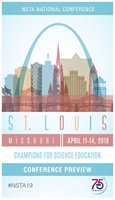Is It Any Wonder That Thousands of Science Teachers Will Gather in St. Louis to Explore Phenomena This Spring?
By Carole Hayward
Posted on 2019-01-27
Merriam-Webster has several definitions for phenomenon—among them are “an observable fact or event” and “an object or aspect known through the senses rather than by thought or intuition.” And just as they find varied ways to look at the word, so too do science teachers find varied ways to use phenomena in their classrooms. Join your peers this spring in St. Louis to hear creative ideas for doing just that.
The National Science Teachers Association (NSTA) will feature a special strand “Phenomena: Gateway to Learning” at our 2019 National Conference on Science Education, in St. Louis, April 11–14. Our conference organizers recognize that using phenomena in science experiences expands learning. Inclusion of multiple disciplines or subject areas in three-dimensional learning aids in deepening student thinking, learning, and reflecting. This strand will show how teachers can use structures such as the 5E instructional model, Claims-Evidence-Reasoning (CER), Problem-Based Learning, Place-Based Learning, or Project-Based Learning as viable approaches to facilitate student understanding. This strand will be targeted by level: novice, intermediate, or advanced attendees.
Sessions organized around this strand include a featured panel on Friday, April 12, 3:30 to 4:30 PM (“Place-Based Phenomena for Extraordinary Learning”) by Leslie Cook, Senior Director, Teacher Learning Center, Teton Science Schools; Kevin Krasnow, Graduate Faculty and Research Specialist, Teton Science Schools; and Joe Petrick, Vice President of Field Education, Teton Science Schools. Teton Science Schools (TSS) has practiced place-based science learning in the Greater Yellowstone Geo-ecosystem for the past 51 years. This panel discussion will focus on how TSS is practicing place-based education and offer new ideas for teachers to take back to their classrooms.
And there will be hundreds more sessions in St. Louis that explore the use of phenomena in the science classroom; below is a small sampling:
- Student Engineers Build on Foundations
- NASA’s Educator Tool Kit: Framing Phenomena-Based Student Investigations
- Daytime Astronomy: Elementary Celestial Navigation
- NOS Naturally
- Harry Potter and the Science of Invisibility
- Do Your Students Really Understand Chemical Equilibrium?
- Students Collecting Data for the GLOBE Urban Heat Island Effect Campaign
- It’s All About Connections: Antarctic Ice to Local Climate
- The Saint Louis Box Turtle Project: Using Local Species to Understand World Issues
- SC-7: Promoting Children’s Science Inquiry and Thinking About Living Things in Preschool and Kindergarten (ticket required)
- Invigorate Your Classroom Through Science Literacy
- What Happened Here? Using the 5Es to Explore Phenomena Outdoors
- Phenomenon-“Mah na mah na:” How to Use a Local Anchoring Phenomena to Drive a Lesson Series
- SC-11: The World Ender: A NASA Cross-Disciplinary PBL Unit (ticket required)
- Place-Based Curricula and Project-Based Learning Units Address a Real-World Problem of Marine Debris in the U.S. Virgin Islands
- CER…CERtainly a Way to Help Students Become Scientists
- Wild Spiders in Three Dimensions
- Climate Science and Stewardship Project: Plants as Bioindicators and Solutions
- After an Earthquake: Real-Time Earthquake Data as a Hook to Encourage Answer-Seeking About the Geologic and Societal Context of the Event
- Science Curriculum from the Grassroots
- Jurassic Mystery: Using Real Research to Teach Critical-Thinking Skills
- Phenomenon-Based Learning: The Other PBL Approach to STEM Instruction
- Biophilia and Young Scientists
 Need some off-campus inspiration? Consider this special offer for St. Louis conference registrants: Show your NSTA St. Louis Conference Badge and receive complimentary admission to the Butterfly House for a self-guided tour, courtesy of the Missouri Botanical Garden. Great care was taken in the design and engineering of the 8,000-square-foot glass conservatory garden to assure a natural and safe habitat for the butterflies. As many as 80 butterfly species and 150 tropical plant species are exhibited. The Butterfly House is located at Faust Park, 15193 Olive Blvd., Chesterfield, MO (a 40-minute drive from America’s Center).
Need some off-campus inspiration? Consider this special offer for St. Louis conference registrants: Show your NSTA St. Louis Conference Badge and receive complimentary admission to the Butterfly House for a self-guided tour, courtesy of the Missouri Botanical Garden. Great care was taken in the design and engineering of the 8,000-square-foot glass conservatory garden to assure a natural and safe habitat for the butterflies. As many as 80 butterfly species and 150 tropical plant species are exhibited. The Butterfly House is located at Faust Park, 15193 Olive Blvd., Chesterfield, MO (a 40-minute drive from America’s Center).
Pro Tips
Check out more sessions and other events with the St. Louis Session Browser. Follow all our conference tweets using #NSTA19, and if you tweet, please feel free to tag us @NSTA so we see it!
Need help requesting funding or time off from your principal or supervisor? Download a letter of support and bring it with you.
And don’t forget, NSTA members save up to $90 off the price of registration. Not a member? Join here.
Future NSTA Conferences
2019 National Conference
St. Louis, April 11–14
2019 STEM Forum & Expo
San Francisco, July 24–26
The mission of NSTA is to promote excellence and innovation in science teaching and learning for all.
Follow NSTA
Disclaimer: The views expressed in this blog post are those of the author(s) and do not necessarily reflect the official position of the National Science Teaching Association (NSTA).


